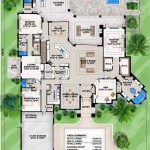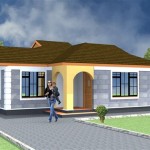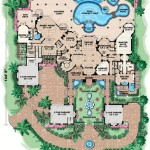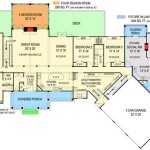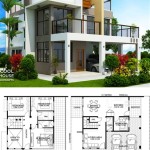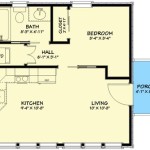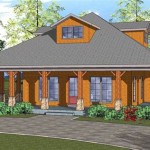Modern Farmhouse Plans: Designing Your 4-Bedroom Dream Home
The modern farmhouse aesthetic has become a dominant trend in residential architecture, seamlessly blending the rustic charm of traditional farmhouses with contemporary design principles. This style prioritizes comfortable living, natural light, and functional layouts, often incorporating elements like exposed beams, shiplap walls, and large, inviting porches. When planning a 4-bedroom modern farmhouse, careful consideration must be given to spatial arrangement, material selection, and the overall flow of the home to ensure it meets the needs of a growing family while maintaining the desired aesthetic.
A 4-bedroom house plan offers ample space for families with children or those who frequently host guests. The specific configuration of these bedrooms can vary widely, depending on the size of the lot, the desired architectural style, and the individual needs of the homeowner. Common layouts may include a master suite with an ensuite bathroom and walk-in closet, two or three additional bedrooms, and one or more shared bathrooms. Some plans may also incorporate a guest suite with its own private bathroom, enhancing privacy and comfort for visitors.
Designing a modern farmhouse involves more than just selecting the right materials and finishes. It requires a holistic approach that considers the entire building site, the surrounding landscape, and the lifestyle of the occupants. Factors such as sunlight orientation, prevailing winds, and existing vegetation can significantly impact the design of the home, influencing the placement of windows, the orientation of outdoor living spaces, and the overall energy efficiency of the structure.
Key Considerations for Layout and Spatial Arrangement
A well-designed layout is crucial for creating a functional and comfortable 4-bedroom modern farmhouse. The placement of bedrooms, common areas, and service spaces should be carefully considered to optimize flow, minimize noise transmission, and maximize natural light. In many modern farmhouse plans, the kitchen serves as the heart of the home, often opening directly onto the living and dining areas. This open-concept design promotes social interaction and allows for a seamless transition between different activities.
The master suite is typically located in a more private area of the home, away from the main living spaces and other bedrooms. This separation provides a sense of retreat and allows the homeowners to enjoy a peaceful and relaxing environment. Children's bedrooms are often grouped together, either on the same floor as the master suite or in a separate wing of the house. This arrangement allows parents to easily monitor their children while still maintaining some privacy.
The inclusion of mudrooms is a hallmark of the modern farmhouse design, providing a dedicated space for storing coats, shoes, and other outdoor gear. Mudrooms are typically located near the entrance of the home, often connecting the garage or driveway to the main living areas. This helps to keep dirt and debris from being tracked into the house, maintaining a cleaner and more organized living environment.
Flexibility is another important consideration when designing a 4-bedroom modern farmhouse. The inclusion of spaces that can be easily adapted to different uses, such as a home office, a playroom, or a media room, can significantly enhance the functionality of the home. These spaces should be designed with adaptability in mind, allowing them to be easily reconfigured as the needs of the family change over time.
Material Selection and Aesthetic Details
The material palette for a modern farmhouse is often characterized by a blend of natural and contemporary elements. Traditional materials such as wood, stone, and brick are frequently combined with more modern materials such as metal, glass, and concrete. This combination creates a visually appealing contrast that reflects the essence of the modern farmhouse aesthetic.
Shiplap siding is a defining feature of many modern farmhouses, adding texture and visual interest to the exterior of the home. This type of siding consists of interlocking wooden planks that create a clean, horizontal line pattern. Shiplap can also be used on interior walls to create a cohesive and rustic look.
Exposed beams are another common element in modern farmhouse design, adding character and warmth to the interior spaces. These beams can be made from a variety of materials, including reclaimed wood, timber, and steel. They often run along the ceiling, adding visual interest and creating a sense of height and spaciousness.
Large windows are essential for maximizing natural light in a modern farmhouse. These windows should be strategically placed to capture sunlight from different angles throughout the day, creating a bright and airy living environment. Consider incorporating large picture windows, transom windows, and skylights to enhance the natural lighting in the home.
The use of neutral colors is also a key characteristic of the modern farmhouse aesthetic. White, gray, beige, and other soft hues are commonly used for walls, ceilings, and trim. These colors create a sense of calm and serenity, allowing the natural materials and architectural details of the home to take center stage.
Energy Efficiency and Sustainable Design
Incorporating energy-efficient and sustainable design principles into a 4-bedroom modern farmhouse is essential for reducing environmental impact and lowering utility costs. This can be achieved through a variety of strategies, including proper insulation, energy-efficient windows and doors, and the use of renewable energy sources.
Proper insulation is crucial for maintaining a comfortable indoor temperature and reducing energy consumption. Insulating walls, ceilings, and floors helps to prevent heat loss in the winter and heat gain in the summer, reducing the need for heating and cooling systems.
Energy-efficient windows and doors can also significantly reduce energy consumption. Look for windows and doors with low U-factors and high solar heat gain coefficients (SHGC) to minimize heat transfer. Consider using double-paned or triple-paned windows with low-E coatings to further enhance energy efficiency.
The use of renewable energy sources, such as solar panels and geothermal systems, can help to reduce reliance on fossil fuels and lower energy costs. Solar panels can be installed on the roof of the home to generate electricity, while geothermal systems can be used to heat and cool the home using the earth's natural temperature.
Water conservation is another important aspect of sustainable design. Consider installing low-flow toilets, showerheads, and faucets to reduce water consumption. Rainwater harvesting systems can also be used to collect rainwater for irrigation purposes, further reducing reliance on municipal water supplies.
In conclusion, designing a 4-bedroom modern farmhouse requires careful planning and attention to detail. By considering the key aspects of layout, material selection, and energy efficiency, homeowners can create a beautiful, functional, and sustainable home that reflects their personal style and meets the needs of their family.

House Plan 041 00160 Country 2 686 Square Feet 4 Bedrooms 5 Bathrooms Farmhouse Floor Plans

Pin On Brandon

One Story 4 Bed Modern Farmhouse Plan With Home Office 51841hz Architectural Designs House Plans

Plan 51830hz Expanded 4 Bed Modern Farmhouse With A Game Room And Bonus Craftsman House Plans Style

Modern Farmhouse Home Plan 4 Bedrms 3 5 Baths 3467 Sq Ft 100 1332

4 Bedroom Farmhouse Plans Floor Designs Houseplans Com

4 Bedroom 1 Story Modern Farmhouse Style Plan With Outdoor Living Area And Bonus Room Westchester Craftsman House Plans

Simple 4 Bedroom Modern Farmhouse Plan 500022vv Architectural Designs House Plans

Modern Farmhouse Travars Built Homes

Plan 51830hz Expanded 4 Bed Modern Farmhouse With A Game Room And Bonus Craftsman House Plans Style

